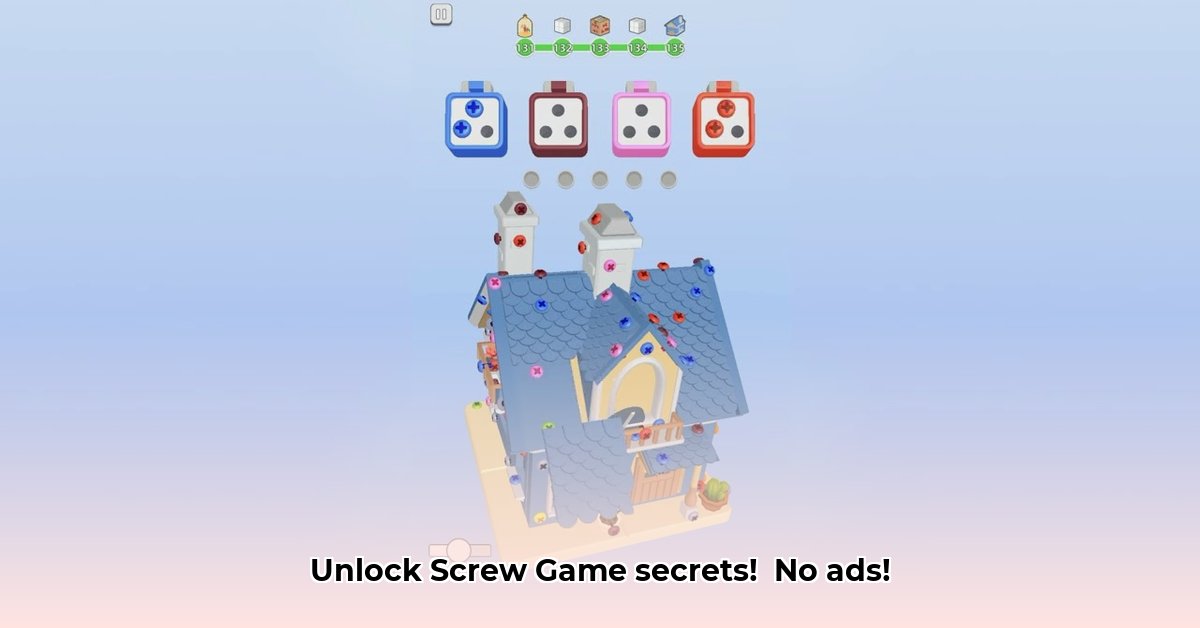
Ever felt the satisfying click of a perfectly tightened screw? Screw-based puzzle games offer a unique blend of strategic thinking and tactile satisfaction—especially the ad-free versions that let you focus on the challenge. This guide dives deep into these brain-bending games, teaching you the ropes and offering expert tips to master the art of unscrewing victory. Prepare to become a master puzzle solver!
Mastering the Core Mechanics: A Step-by-Step Guide
Screw-based puzzle games often share a deceptively simple core mechanic: unscrewing virtual components to solve puzzles. However, mastering this deceptively simple mechanic is key! Let's break it down:
Assess the Puzzle: Begin by thoroughly examining the puzzle. Identify the different screw types (Phillips, slotted, hex, etc.), their locations, and any obstacles. This initial reconnaissance is crucial. What are the key components, and how do they interact?
Select the Right Tool: Choose the appropriate virtual tool—screwdriver, wrench, etc.—for each screw type. Using the wrong tool will only lead to frustration. Is there a tool that can multitask? This is an important optimization strategy in many games.
Precise Manipulation: Carefully unscrew the components. Some puzzles require precise movements, while others allow for more leeway. Observe how one action affects the rest of the puzzle. Are there any hidden mechanisms revealed by unscrewing certain parts?
Adapt your Strategy: The interconnectedness of these puzzles is often stunning. The solution may not always be linear. Experiment freely. Did you accidentally find a shortcut? This is a clear sign of a well-designed game, but careful planning is still encouraged.
Victory is Yours!: Once all components are correctly unscrewed, the puzzle is solved! That satisfying "click"—or its digital equivalent—is your reward.
Level Progression and Design: Increasing Complexity
The beauty lies in the gradual difficulty curve. Early levels introduce basic mechanics, while later stages introduce:
Increased Screw Count: More screws, often of different types, significantly increase the complexity. Multiple screws might interact, requiring strategic prioritization. How do you determine which screw to tackle first?
Complex Mechanisms: Expect intricate gear systems, hidden compartments, and moving parts to increase the challenge. You may need to unscrew in a specific sequence.
Time Constraints: Some levels introduce time pressures, testing both your speed and strategic thinking.
Review: A Critical Look at Screw Puzzle Games
Screw-based puzzle games often vary wildly in visual style, ranging from photorealistic 3D to charming cartoon aesthetics. The sound design typically features satisfying metallic clicks and clangs, enhancing the interactive experience. However, potential drawbacks include:
Frustration Factor: While intellectually stimulating, some puzzles can be extraordinarily challenging, leading to player frustration. How does the game handle player frustration?
Visual Style: While often appealing, the visual style might not cater to all tastes, varying across game titles.
Difficulty Spikes: The smooth difficulty progression isn't always guaranteed. Sudden difficulty increases can derail progress.
Accessibility: While generally easy to play, some games may lack features that enhance accessibility for players with certain disabilities.
Tips and Tricks: Mastering the Art of Unscrewing
Successful screw puzzle gameplay hinges on:
Patience and Planning: Don't rush; methodical planning is critical for solving complex puzzles. Analyze the puzzle before making any moves.
Experimentation: Trial and error are perfectly acceptable tactics. Be open to trying different approaches if your initial strategy fails.
Pattern Recognition: Look for visual clues or patterns in the arrangement of screws and components. These hints often guide you towards a solution.
Breaks are Beneficial: If you're stuck, stepping away for a short period can offer a fresh perspective.
Advanced Screw Mechanics: Beyond the Basics
As your skills develop, expect to encounter:
Hidden Screws: These are cleverly concealed, requiring careful observation and often the manipulation of environmental elements to access.
Screw Diversity: Several types of screws may require specialized tools. Careful tool selection and efficient tool usage is very important.
Interactive Environments: The puzzle's surroundings may play an active role, with moving platforms or levers that influence screw accessibility.
In conclusion, screw-based puzzle games offer a unique and rewarding experience. The satisfying puzzle-solving mechanics, combined with the strategic thinking involved, make them compelling for players of all skill levels. Remember to approach each puzzle methodically, experiment with different approaches, and don't be afraid to ask for help or take a break when necessary. Happy unscrewing!
⭐⭐⭐⭐☆ (4.8)
Download via Link 1
Download via Link 2
Last updated: Saturday, May 10, 2025